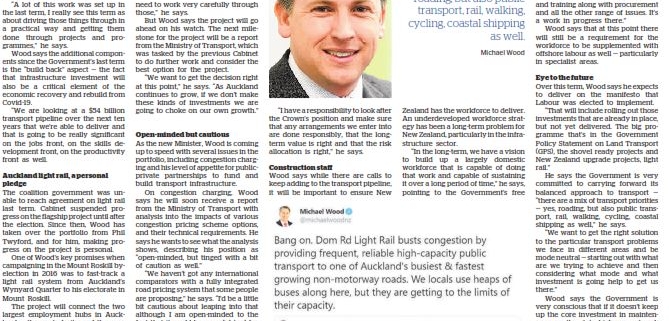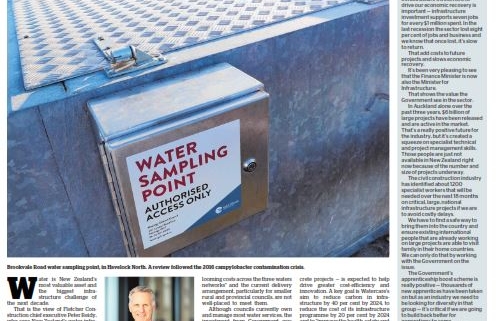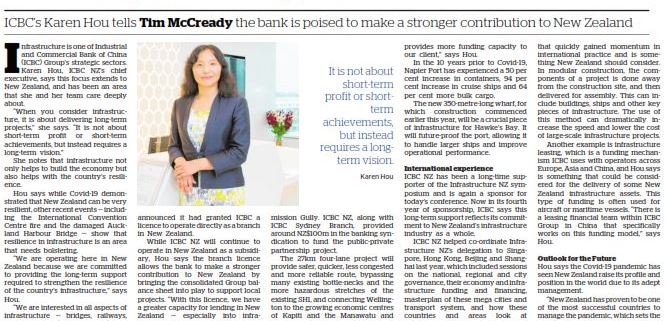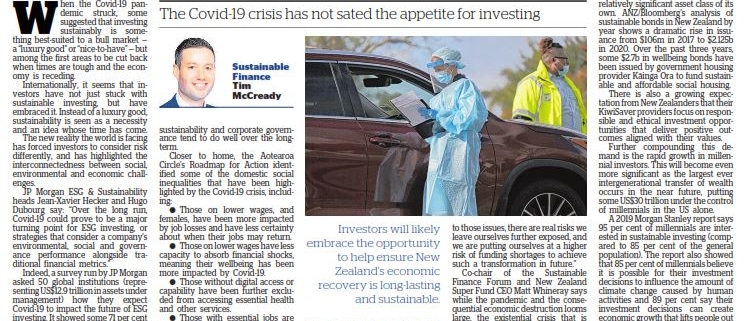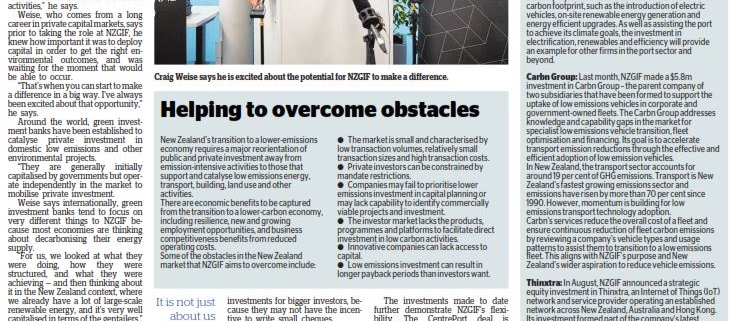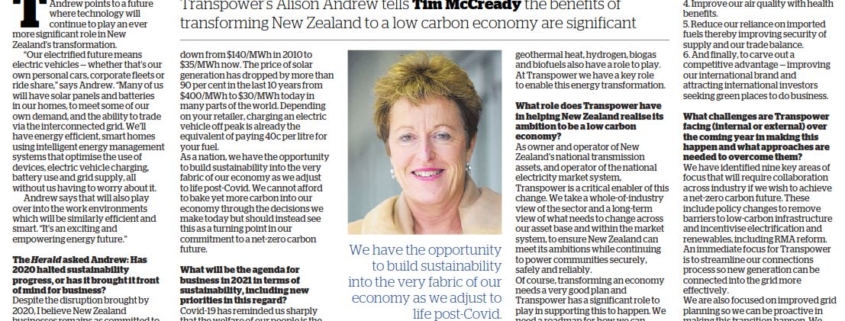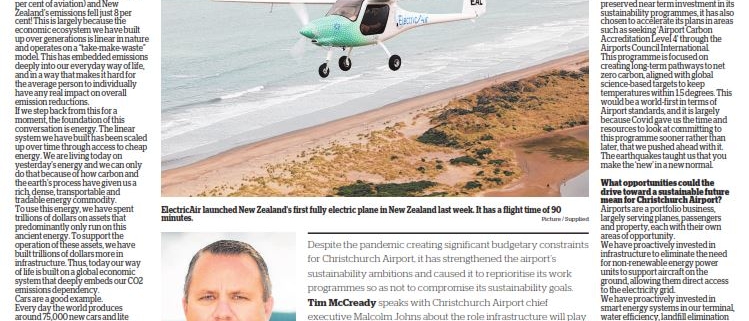Infrastructure: Bridging the troubled water gap (NZ Herald)
Infrastructure: Bridging the troubled water gap (NZ Herald)
Water is New Zealand’s most valuable asset and the biggest infrastructure challenge of the next decade.
That is the view of Fletcher Construction chief executive Peter Reidy, who says New Zealand’s water infrastructure is well overdue for investment as pipes reach the end of their useful lives.
Reidy says that more than a third of wastewater treatment plants will require re-consenting within the next decade, and almost a quarter are operating on expired consents. Conservative estimates are that the cost of upgrades and renewals will be measured in billions of dollars.
“The public’s environmental expectations are also increasing and the consequences of climate change, including more frequent and more intense droughts, require urgent attention,” he says.
Over the past three years, central and local government have been considering how to address the challenges facing delivery of three waters services (drinking water, wastewater, stormwater) to communities. The review followed the 2016 Havelock North campylobacter contamination crisis that exposed systemic issues in the regulation and provision of three waters.
The result has been the establishment of Taumata Arowai as a Crown water regulatory body to administer and enforce a drinking water regulatory framework, with additional oversight on improving the environmental performance of wastewater and stormwater networks.
In July this year, as part of the Covid-19 stimulus, the Government announced $761 million in funding to maintain and improve three waters infrastructure and to support the reform of local government water services delivery arrangements.
At the funding announcement, Local Government Minister Nanaia Mahuta said there are “massive looming costs across the three waters networks” and the current delivery arrangement, particularly for smaller rural and provincial councils, are not well-placed to meet them.
Although councils currently own and manage most water services, the investment from Government was made contingent on local councils opting in to the government’s wider reform programme.
Fletcher Construction supports the Government’s plans to reform the way we manage water.
“At the end of the day it is all about customers — improving environmental standards, value for money and productivity for customers,” says Reidy. “Having water utilities at scale will also allow for greater investment in digital solutions to water.”
Fletcher Construction has brought together two of its businesses — Fletcher Construction Infrastructure and Brian Perry Civil — to support the establishment of capital construction plus operations and maintenance for water assets to help local government meet their challenges.
In September, Fletcher Construction along with Fulton Hogan signed a $2.4 billion contract with Auckland Council-owned Watercare Services for the delivery of water and wastewater infrastructure for Auckland over the next 10 years.
Watercare said the long-term, collaborative partnership is a first for New Zealand. The planned programme of work — rather than discrete projects — is expected to help drive greater cost-efficiency and innovation. A key goal is Watercare’s aim to reduce carbon in infrastructure by 40 per cent by 2024, to reduce the cost of its infrastructure programme by 20 per cent by 2024 and to “improve the health, safety and wellbeing of all people involved in delivering our infrastructure by 20 per cent year-on-year.”
Reidy says the 10-year partnership with Watercare was secured under a new enterprise model which has audacious cost and sustainability goals. “This is a transformational model of partnership built around carbon reduction, safety improvements and cost savings that challenged our team to collaborate across their specialty areas,” he says. “Watercare has changed the way it partners and that has stimulated Fletcher Construction to respond in a way that puts safety, sustainability and innovation at the core of our model.”
Reidy says it is that kind of model that could work across the country.
“With Wellington Water we are also offering more than just a straight subcontractor model. And that’s because real progress can be made when deliverers are embedded within planning and project teams.”
Reidy says the Government has started this conversation, but we all need to collaborate together to find the solutions. “That’s critical for our cities, our waterways and our people,” he says.
Infrastructure: ICBC - strengthening our resilience (NZ Herald)
Infrastructure: ICBC – strengthening our resilience (NZ Herald)
Infrastructure is one of Industrial and Commercial Bank of China (ICBC) Group’s strategic sectors.
Karen Hou, ICBC NZ’s chief executive, says this focus extends to New Zealand, and has been an area that she and her team care deeply about.
“When you consider infrastructure, it is about delivering long-term projects,” she says. “It is not about short-term profit or short-term achievements, but instead requires a long-term vision.”
She notes that infrastructure not only helps to build the economy but also helps with the country’s resilience.
Hou says while Covid-19 demonstrated that New Zealand can be very resilient, other recent events — including the International Convention Centre fire and the damaged Auckland Harbour Bridge — show that resilience in infrastructure is an area that needs bolstering.
“We are operating here in New Zealand because we are committed to providing the long-term support required to strengthen the resilience of the country’s infrastructure,” says Hou.
“We are interested in all aspects of infrastructure — bridges, railways, motorways, water, power, schools, hospitals, ports, airports, aged care — these are all important areas of infrastructure that will provide fundamental support to the country and help the economy.”
Boosted capacity for funding
In May this year, the Reserve Bank announced it had granted ICBC a licence to operate directly as a branch in New Zealand.
While ICBC NZ will continue to operate in New Zealand as a subsidiary, Hou says the branch licence allows the bank to make a stronger contribution to New Zealand by bringing the consolidated Group balance sheet into play to support local projects. “With this licence, we have a greater capacity for lending in New Zealand — especially into infrastructure and green projects,” she says.
ICBC NZ has been active in New Zealand for over seven years now, and has already been involved in several of New Zealand’s major infrastructure projects.
One of the first projects ICBC NZ became involved in was Transmission Gully. ICBC NZ, along with ICBC Sydney Branch, provided around NZ$100m in the banking syndication to fund the public-private partnership project.
The 27km four-lane project will provide safer, quicker, less congested and more reliable route, bypassing many existing bottle-necks and the more hazardous stretches of the existing SH1, and connecting Wellington to the growing economic centres of Kapiti and the Manawatu and subsequently the wider North Island.
ICBC NZ, along with ICBC Asia, has also recently provided funding to assist Napier Port with their capital investment programme, which includes the development of the new 6 Wharf. “We have been able to leverage the wider ICBC Group’s global resources for this project which provides more funding capacity to our client,” says Hou.
In the 10 years prior to Covid-19, Napier Port has experienced a 50 per cent increase in containers, 94 per cent increase in cruise ships and 64 per cent more bulk cargo.
The new 350-metre-long wharf, for which construction commenced earlier this year, will be a crucial piece of infrastructure for Hawke’s Bay. It will future-proof the port, allowing it to handle larger ships and improve operational performance.
International experience
ICBC NZ has been a long-time supporter of the Infrastructure NZ symposium and is again a sponsor for today’s conference. Now in its fourth year of sponsorship, ICBC says this long-term support reflects its commitment to New Zealand’s infrastructure industry as a whole.
ICBC NZ helped co-ordinate Infrastructure NZ’s delegation to Singapore, Hong Kong, Beijing and Shanghai last year, which included sessions on the national, regional and city governance, their economy and infrastructure funding and financing, masterplan of these mega cities and transport system, and how these countries and areas look at prioritising their investment planning.
Hou says some of the experiences from international practice for New Zealand include the public-private partnership models, alternative construction methods and new funding mechanisms.
Modular construction is an area that quickly gained momentum in international practice and is something New Zealand should consider. In modular construction, the components of a project is done away from the construction site, and then delivered for assembly.
This can include buildings, ships and other key pieces of infrastructure. The use of this method can dramatically increase the speed and lower the cost of large-scale infrastructure projects.
Another example is infrastructure leasing, which is a funding mechanism ICBC uses with operators across Europe, Asia and China, and Hou says is something that could be considered for the delivery of some New Zealand infrastructure assets. This type of funding is often used for aircraft or maritime vessels. “There is a leasing financial team within ICBC Group in China that specifically works on this funding model,” says Hou.
Outlook for the Future
Hou says the Covid-19 pandemic has seen New Zealand raise its profile and position in the world due to its adept management.
“New Zealand has proven to be one of the most successful countries to manage the pandemic, which sets the country up well for future investment — because people want to invest in countries that can demonstrate they are resilient,” she says.
Hou hopes that the opportunity the recovery presents will help New Zealand with its economy, and ultimately ensure its infrastructure is as resilient as it can be.
Sustainability is a necessity now
The Covid-19 crisis has not sated the appetite for investing
When the Covid-19 pandemic struck, some suggested that investing sustainably is something best-suited to a bull market — a “luxury good” or “nice-to-have” — but among the first areas to be cut back when times are tough and the economy is receding.
Internationally, it seems that investors have not just stuck with sustainable investing, but have embraced it. Instead of a luxury good, sustainability is seen as a necessity and an idea whose time has come.
The new reality the world is facing has forced investors to consider risk differently, and has highlighted the interconnectedness between social, environmental and economic challenges.
JP Morgan ESG & Sustainability heads Jean-Xavier Hecker and Hugo Dubourg say: “Over the long run, Covid-19 could prove to be a major turning point for ESG investing, or strategies that consider a company’s environmental, social and governance performance alongside traditional financial metrics.”
Indeed, a survey run by JP Morgan asked 50 global institutions (representing US$12.9 trillion in assets under management) how they expect Covid-19 to impact the future of ESG investing. It showed some 71 per cent think it is “rather likely”, “likely”, or “very likely” that a low probability-high impact risk like Covid-19 would increase awareness and actions globally to tackle high impact-high probability risks such as those related to climate change and biodiversity losses.
More immediately, the pandemic has seen investors turn to sustainable and responsible investments as a form of safe haven. This is because companies with strong records on employee relations, environmental sustainability and corporate governance tend to do well over the long-term.
Closer to home, the Aotearoa Circle’s Roadmap for Action identified some of the domestic social inequalities that have been highlighted by the Covid-19 crisis, including:
· Those on lower wages, and females, have been more impacted by job losses and have less certainty about when their jobs may return.
· Those on lower wages have less capacity to absorb financial shocks, meaning their wellbeing has been more impacted by Covid-19.
· Those without digital access or capability have been further excluded from accessing essential health and other services.
· Those with essential jobs are the people we rely upon during a pandemic. Yet they receive little compensation above the minimum wage. This has led to the stark realisation that we need to value these people differently and need to re-think our ideas of value.
The Aotearoa Circle says the rapid behavioural change in response to the pandemic has shown how innovative and adaptive we can be.
It suggests that governments stepping in to become some of the largest consumers via various stimulus programs presents a crucial opportunity to serve two purposes: economic recovery and a climate change crisis recovery.
The Roadmap for Action says: “Our recovery needs to look to reduce the social and environmental imbalances that disrupt our society, and make our economy more resilient for the next generation.
“If the huge stimulus does not simultaneously contribute towards a more resilient, sustainable economy, or worse, sets us back in our response to those issues, there are real risks we leave ourselves further exposed, and we are putting ourselves at a higher risk of funding shortages to achieve such a transformation in future.”
Co-chair of the Sustainable Finance Forum and New Zealand Super Fund CEO Matt Whineray says while the pandemic and the consequential economic destruction looms large, the existential crisis that is climate change is not going away — and will continue to worsen.
“Responding to the pandemic in a way which exacerbates the climate crisis, would be a global policy failure,” he says.
While New Zealand may have lagged behind some of the large international markets, investment in areas that reduce global carbon emissions and address essential social services is rapidly growing.
For example, New Zealand’s sustainable bond issuance is becoming a relatively significant asset class of its own. ANZ/ Bloomberg’s analysis of sustainable bonds in New Zealand by year shows a dramatic rise in issuance from $106m in 2017 to $2.125b in 2020. Over the past three years, some $2.7b in wellbeing bonds have been issued by government housing provider Kāinga Ora to fund sustainable and affordable social housing.
There is also a growing expectation from New Zealanders that their KiwiSaver providers focus on responsible and ethical investment opportunities that deliver positive outcomes aligned with their values.
Further compounding this demand is the rapid growth in millennial investors. This will become even more significant as the largest ever intergenerational transfer of wealth occurs in the near future, putting some US$30 trillion under the control of millennials in the US alone.
A 2019 Morgan Stanley report says 95 per cent of millennials are interested in sustainable investing (compared to 85 per cent of the general population). The report also showed that 85 per cent of millennials believe it is possible for their investment decisions to influence the amount of climate change caused by human activities and 89 per cent say their investment decisions can create economic growth that lifts people out of poverty.
As the government and large corporates in New Zealand ramp up the delivery on their productivity, social and environmental aspirations, the call from investors for increased sustainable investment opportunities will be answered.
Investors will likely embrace the opportunity to provide some of the significant capital flow that will be needed to help ensure New Zealand’s economic recovery is long-lasting and sustainable.
New Zealand Green Investment Finance has made three investments, and is eager for more, writes Tim McCready
New Zealand Green Investment Finance has made three investments, and is eager for more, writes Tim McCready
New Zealand Green Investment Finance (NZGIF) was established by the Government to help New Zealand achieve a transition to a lower emissions economy, as part of a global movement to finance ways to mitigate the effects of climate change.
The green investment bank has an initial capital fund of $100 million. It is tasked with stimulating a market in which private capital flows to investment in activity that reduces our domestic emissions.
NZGIF’s chief executive, Craig Weise, says one of the ways to do that is to lead the market by demonstrating not just the greenhouse gas benefits of its investment, but commercial and other benefits as well.
“I think that’s one of the big aspects of our mission that is really important, which at its core is about acceleration of investment in lower emissions activities,” he says.
Weise, who comes from a long career in private capital markets, says prior to taking the role at NZGIF, he knew how important it was to deploy capital in order to get the right environmental outcomes, and was waiting for the moment that would be able to occur.
“That’s when you can start to make a difference in a big way. I’ve always been excited about that opportunity,” he says.
Around the world, green investment banks have been established to catalyse private investment in domestic low emissions and other environmental projects.
“They are generally initially capitalised by governments but operate independently in the market to mobilise private investment.
Weise says internationally, green investment banks tend to focus on very different things to NZGIF because most economies are thinking about decarbonising their energy supply.
“For us, we looked at what they were doing, how they were structured, and what they were achieving — and then thinking about it in the New Zealand context, where we already have a lot of large-scale renewable energy, and it’s very well capitalised in terms of the gentailers.”
Broad investment mandate
So far, NZGIF has made three investments: Thinxtra, an Internet of Things network and service provider; Carbn Group, supporting the uptake of low emissions vehicles in corporate and government-owned fleets; and CentrePort, a transport and property infrastructure firm.
Each of the deals NZGIF has done to date are quite different, and Weise says that — to a certain extent — this has been a deliberate move.
The deals that have been done help to illustrate to the market the breadth of what NZGIF can do, as well as signal the areas it sees as being economic and investible.
“It is not just about us deploying our own capital — it is also about showing the market that these things are there,” says Weise. “It has been really important for us to go out and build institutional credibility in the market.
“Do the deals, let people understand us.”
A flexible approach
NZGIF can invest through a range of capital structures, from debt to equity, with mechanisms to mitigate risk for its partners.
It will be able to create solutions with the market that are hard for other institutions to do because of how it can use a balance sheet.
Its role will be different depending on what the need is. In some cases, it will need to aggregate sub-scale investments for bigger investors, because they may not have the incentive to write small cheques.
In other cases, NZGIF will get opportunities outside of corporate balance sheets that don’t make sense on their own, but make sense when you start to pool them.
It will also be able to de-risk some projects — for example where it is the first time something is being done in New Zealand. While a bank might get stuck on a particular risk, NZGIF can take the risk on more easily, unlocking a deal that might have huge carbon benefits for the country.
“One of the things about the market in New Zealand is that because we’re a small market from a capital markets perspective, some of those things are just a function of being a small market,” he says.
“It’s not only because there is an emerging understanding around low carbon and green investment — it’s because we’re a small market.”
Weise says this flexibility is one of NZGIF’s key points of difference as an institution. “We are not called a fund for a reason — because funds behave in very specific ways,” he says.
“That is very powerful for us in achieving our mission, but it’s also a bit confusing, because we have a lot more flexibility in terms of how we use the balance sheet, and we are operating over time horizons that are much, much longer than most funds would be thinking about.”
That time horizon is not necessarily around the duration of the finance, but defines how NZGIF is thinking: helping New Zealand get to net zero emissions by 2050.
The investments made to date further demonstrate NZGIF’s flexibility. The CentrePort deal is structured as a straightforward senior credit facility, where it is able to draw down money and pay NZGIF interest. The facility has a term, along with a set of rules around how the capital can be used and for what purpose.
The Carbn Group deal is an example of a hybrid investment. NZGIF has put both debt and equity into the company.
Weise says this is because the group is doing two different activities: one side of the business provides advisory services for government and corporates looking to optimise their vehicle fleets, the other side specialises in financing low emissions vehicles, with expertise in the economics of electric vehicles.
“With Carbn Group we saw a gap in the market that needed to be filled to help us to transition holistically,” says Weise.
“And we liked it in particular because a lot of vehicles come into the country via fleets, and then into domestic use later on. It’s a way to increase that uptake a little bit faster — coming back to our acceleration mission.”
A healthy pipeline
Weise says it is very encouraging that there continues to be a very healthy pipeline of opportunity: “You’ll see us continue to make announcements on a fairly regular basis.”
But he says beyond doing deals, NZGIF is very focused on bringing other capital providers along with it. It aims to work with a broad range of partners, including financial markets and investors, banks, private companies, local government and global green banking networks.
“NZGIF can’t do it alone, because the delta is much, much bigger than its own balance sheet,” says Weise.
“There are so many ways we can participate with the market.
“It’s quite exciting as a practitioner, because it is on you to have that sort of flexibility,” he says.
“We would encourage other institutions who see — or want — opportunity, to come and talk to us.”
Investments made to date
CentrePort: CentrePort is a transport and property infrastructure firm, built around its core port business on Wellington Harbour. It provides supply chain solutions and expertise including the CentreRail Service with KiwiRail, and a network of inland cargo hubs. CentrePort facilitates international and coastal shipping, the inter-island Cook Strait ferry services, and land and aviation fuel supplies.
CentrePort was NZGIF’s first investment, announced in June 2020. The green credit facility of $15m will be used to provide the finance needed to accelerate the deployment of low carbon projects, with the capital ensuring the projects remain a priority and are developed alongside the wider regeneration of the port. NZGIF’s lending will be exclusively used to fund low-carbon projects which will reduce CentrePort’s overall carbon footprint, such as the introduction of electric vehicles, on-site renewable energy generation and energy efficient upgrades. As well as assisting the port to achieve its climate goals, the investment in electrification, renewables and efficiency will provide an example for other firms in the port sector and beyond.
Carbn Group: Last month, NZGIF made a $5.8m investment in Carbn Group – the parent company of two subsidiaries that have been formed to support the uptake of low emissions vehicles in corporate and government-owned fleets. The Carbn Group addresses knowledge and capability gaps in the market for specialist low emissions vehicle transition, fleet optimisation and financing. Its goal is to accelerate transport emission reductions through the effective and efficient adoption of low emission vehicles.
In New Zealand, the transport sector accounts for around 19 per cent of GHG emissions. Transport is New Zealand’s fastest growing emissions sector and emissions have risen by more than 70 per cent since 1990. However, momentum is building for low emissions transport technology adoption.
Carbn’s services reduce the overall cost of a fleet and ensure continuous reduction of fleet carbon emissions by reviewing a company’s vehicle types and usage patterns to assist them to transition to a low emissions fleet. This aligns with NZGIF’s purpose and New Zealand’s wider aspiration to reduce vehicle emissions.
Thinxtra: In August, NZGIF announced a strategic equity investment in Thinxtra, an Internet of Things (IoT) network and service provider operating an established network across New Zealand, Australia and Hong Kong. Its investment formed part of the company’s latest funding round alongside other investors.
Thinxtra’s technology supports firms to improve efficiency and asset utilisation, with clear carbon benefits. It has built, owns and supports the 0G Network, powered by Sigfox technology, which is low-cost, resilient and capable of supporting high volumes of connected devices, using very little energy to run. These devices allow companies to, for example, use less power, travel less and save carbon.
One example NZGIF gives of how the technology could be applied is the NZ predator free programme. Pest traps could be remotely monitored, meaning traditional scheduled checks in remote areas can be made more efficient by a smart trap triggering a check only when a predator has been captured. The same OG Network can be used to provide better insights into assets in the area, geolocation and safety of people (rangers and volunteers) and the overall health of the environment.
NZGIF says IoT provides a significant opportunity to reduce carbon emissions, and its investment in Thinxtra will help support a dynamic market leader to accelerate the deployment of its technology in New Zealand and enable firms to reduce their emissions as well as save money.
Electrifying the economy
Transpower’s Alison Andrew tells Tim McCready the benefits of transforming New Zealand to a low carbon economy are significant
Transpower CEO Alison Andrew points to a future where technology will continue to play an ever more significant role in New Zealand’s transformation.
“Our electrified future means electric vehicles — whether that’s our own personal cars, corporate fleets or ride share,” says Andrew. “Many of us will have solar panels and batteries in our homes, to meet some of our own demand, and the ability to trade via the interconnected grid. We’ll have energy efficient, smart homes using intelligent energy management systems that optimise the use of devices, electric vehicle charging, battery use and grid supply, all without us having to worry about it.
Andrew says that will also play over into the work environments which will be similarly efficient and smart. “It’s an exciting and empowering energy future.”
The Herald asked Andrew: Has 2020 halted sustainability progress, or has it brought it front of mind for business?
Despite the disruption brought by 2020, I believe New Zealand businesses remains as committed to progressing sustainability as before. Stakeholders and investors are demanding that we all commit to action and make greater progress toward delivering on sustainable outcomes. We have a responsibility to our customers, communities and employees that we consider the social and environmental impacts of all that we do — and take steps to ensure positive outcomes.
Economically, it already makes sense. The price of wind generation is one quarter of what it was 10 years ago, down from $140/MWh in 2010 to $35/MWh now. The price of solar generation has dropped by more than 90 per cent in the last 10 years from $400/MWh to $30/MWh today in many parts of the world. Depending on your retailer, charging an electric vehicle off peak is already the equivalent of paying 40c per litre for your fuel.
As a nation, we have the opportunity to build sustainability into the very fabric of our economy as we adjust to life post-Covid. We cannot afford to bake yet more carbon into our economy through the decisions we make today but should instead see this as a turning point in our commitment to a net-zero carbon future.
What will be the agenda for business in 2021 in terms of sustainability, including new priorities in this regard?
Covid-19 has reminded us sharply that the welfare of our people is the most critical element of our success. Having highly engaged, skilled and capable people is central to all that we do and for Transpower and has enabled us to continue delivering our service despite the disruptions. We recognise that it is essential we make the most of the strengths inherent in having a diverse and inclusive workforce and culture. We are committed to the ongoing development of our people and our organisation.
To achieve the county’s net-zero carbon emissions, we need to electrify our economy. It starts by shifting the transport sector off oil and on to electric vehicles, trucks and buses. We also need to shift heat used in industry processes or for heating our large commercial and public buildings, from coal and gas, and on to electricity. Renewable electricity will power this transformation and will be the main part of the energy puzzle although biomass, direct geothermal heat, hydrogen, biogas and biofuels also have a role to play. At Transpower we have a key role to enable this energy transformation.
What role does Transpower have in helping New Zealand realise its ambition to be a low carbon economy?
As owner and operator of New Zealand’s national transmission assets, and operator of the national electricity market system, Transpower is a critical enabler of this change. We take a whole-of-industry view of the sector and a long-term view of what needs to change across our asset base and within the market system, to ensure New Zealand can meet its ambitions while continuing to power communities securely, safely and reliably.
Of course, transforming an economy needs a very good plan and Transpower has a significant role to play in supporting this to happen. We need a roadmap for how we can develop our energy resources and when; what technology and infrastructure is required; what policy and regulatory settings are needed. This is the work we have outlined in our paper Whakamana i Te Mauri Hiko — Empowering our energy future. The benefits of this transformation are significant and an opportunity to:
- Create thousands of new jobs.
- Meet our emissions reduction targets.
- Reduce average household energy bills by around 25 per cent by 2035.
- Improve our air quality with health benefits.
- Reduce our reliance on imported fuels thereby improving security of supply and our trade balance.
- And finally, to carve out a competitive advantage — improving our international brand and attracting international investors seeking green places to do business.
What challenges are Transpower facing (internal or external) over the coming year in making this happen and what approaches are needed to overcome them?
We have identified nine key areas of focus that will require collaboration across industry if we wish to achieve a net-zero carbon future. These include policy changes to remove barriers to low-carbon infrastructure and incentivise electrification and renewables, including RMA reform.
An immediate focus for Transpower is to streamline our connections process so new generation can be connected into the grid more effectively.
We are also focused on improved grid planning so we can be proactive in making this transition happen. We need to do this alongside industry and drawing from the collective knowledge that exists across the sector. The benefit for everyone is that we can all plan for the future, more effectively.
A more challenging nut to crack is ensuring we have access to the skilled workforce needed to deliver on this future. We need improved vocational training, greater workforce diversity and a stronger sector brand that attracts young people motivated by our goal of decarbonisation.
Sustainable Finance: Flying into the future
Despite the pandemic creating significant budgetary constraints for Christchurch Airport, it has strengthened the airport’s sustainability ambitions and caused it to reprioritise its work programmes so as not to compromise its sustainability goals.
Tim McCready speaks with Christchurch Airport chief executive Malcolm Johns about the role infrastructure will play in moving New Zealand toward a lower carbon future and the opportunities it could bring for the airport.
Herald: What are the big challenges we need to overcome as we move toward a low carbon future?
The embedded nature of emissions in our daily lives shows just how hard the task ahead is if we are to stay within the 1.5 degree target set in Paris. For example, during Level 4 lockdown here in New Zealand, we effectively suspended 40 per cent of the national economy (including 90 per cent of aviation) and New Zealand’s emissions fell just 8 per cent! This is largely because the economic ecosystem we have built up over generations is linear in nature and operates on a “take-make-waste” model. This has embedded emissions deeply into our everyday way of life, and in a way that makes it hard for the average person to individually have any real impact on overall emission reductions.
If we step back from this for a moment, the foundation of this conversation is energy. The linear system we have built has been scaled up over time through access to cheap energy. We are living today on yesterday’s energy and we can only do that because of how carbon and the earth’s process have given us a rich, dense, transportable and tradable energy commodity.
To use this energy, we have spent trillions of dollars on assets that predominantly only run on this ancient energy. To support the operation of these assets, we have built trillions of dollars more in infrastructure. Thus, today our way of life is built on a global economic system that deeply embeds our CO2 emissions dependency.
Cars are a good example.
Every day the world produces around 75,000 new cars and lite vehicles. More than 90 per cent of them have combustion engines and will last for several decades into the future, thus embedding new transport emissions into the system.
How can we move away from this reliance on “ancient energy”?
To change this system, we must undertake one of humanity’s largest ever re-tooling events. This will either be a massive re-tooling of the assets towards those that operate on today’s energy (renewable energy) or a massive re-tooling of the way we live. Our choice is either A: change the assets, B: change the people, or C: fail.
For most countries, A is the only real option left as changing the people is a slow process that can really only occur over time. But A requires a change plan and investment on a scale not seen in modern history. It will only happen if we achieve stakeholder equity in the transition. A grand carbon coalition between consumers and shareholders and Government. No one party will achieve such an energy transition on its own. This is incredibly disruptive stuff!
What role will infrastructure play in a lower carbon future?
Modern, sustainable infrastructure will play a key role. Where old infrastructure creates inefficiencies or fails to support lower carbon options for its users, it will need to be left behind in favour of new infrastructure that is sustainable and can support lower carbon futures for its users.
Christchurch Airport has worked to achieve stakeholder equity in many of the changes forced upon it from the earthquakes almost a decade ago. High consequence events give you the opportunity to bring in a “new normal”. It’s your choice how much “new” and how much “normal’ is contained within this. From a sustainability perspective, we have driven our own asset transition plans to ensure our infrastructure, old and new, can support a lower carbon future for our customers and our business. This has required some upfront investment which our shareholders have supported. The result is we have driven almost 90 per cent of Scope 1 CO2 emissions out of our business!
How has Covid-19 changed your ability to execute on your sustainability programmes?
Covid-19 cannot be an excuse for non-execution of sustainability programmes. It is reasonable that it may slow the pace of things in the short term if survival is paramount, but this is why a carbon coalition of stakeholders is important — you can only keep going in times like this when you have stakeholder equity available to allow you to do so.
Christchurch Airport has not only preserved near term investment in its sustainability programmes, it has also chosen to accelerate its plans in areas such as seeking ‘Airport Carbon Accreditation Level 4’ through the Airports Council International.
This programme is focused on creating long-term pathways to net zero carbon, aligned with global science-based targets to keep temperatures within 1.5 degrees. This would be a world-first in terms of Airport standards, and it is largely because Covid gave us the time and resources to look at committing to this programme sooner rather than later, that we pushed ahead with it. The earthquakes taught us that you make the ‘new’ in a new normal.
What opportunities could the drive toward a sustainable future mean for Christchurch Airport?
Airports are a portfolio business, largely serving planes, passengers and property, each with their own areas of opportunity.
We have proactively invested in infrastructure to eliminate the need for non-renewable energy power units to support aircraft on the ground, allowing them direct access to the electricity grid.
We have proactively invested in smart energy systems in our terminal, water efficiency, landfill elimination processes and most importantly, eliminating Scope 1 CO2 emissions from our terminal operation. We are now offering prospective tenants a menu of designed-in sustainability options for new buildings on our campus.
We have committed ourselves to building New Zealand’s greenest airport in Central Otago, to allow airlines to utilise their most carbon efficient aircraft in the future. We would love to see the country take on the challenge of building a multi-region low carbon, integrated transport network around this new site, that will serve Kiwis and their visitors sustainably for generations to come.
The recent announcement from Airbus that it is exploring hydrogen aircraft caught our eye. Christchurch Airport sits on top of one of New Zealand’s largest natural aquifers and has access to acres of land for solar power arrays.

